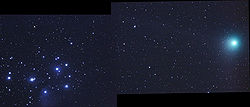
Comet Machholz
Encyclopedia
Comet Machholz, formally designated C/2004 Q2, is a long-period comet
discovered by Donald Machholz
on August 27, 2004.
It reached naked eye
brightness in January 2005. Unusual for such a relatively bright comet, its perihelion was farther from the Sun
than the Earth
's orbit.
of this object, different epochs
can generate quite different heliocentric unperturbed two-body
best-fit
solutions to the aphelion distance (maximum distance) of this object. For objects at such high eccentricity, the Suns barycentric coordinates
are more stable than heliocentric coordinates. Using JPL Horizons the barycentric orbital elements for epoch 2011-Jan-01 generate a semi-major axis
of 537 AU and a period of approximately 12,500 years. This gives it a barycentric orbital period just a little larger than Sedna
.

Comet
A comet is an icy small Solar System body that, when close enough to the Sun, displays a visible coma and sometimes also a tail. These phenomena are both due to the effects of solar radiation and the solar wind upon the nucleus of the comet...
discovered by Donald Machholz
Donald Machholz
Donald Edward Machholz, born October 7, 1952 in Portsmouth, Virginia, is an American amateur astronomer from Colfax, California.He is the most successful living visual comet hunter in the United States, being...
on August 27, 2004.
It reached naked eye
Naked eye
The naked eye is a figure of speech referring to human visual perception unaided by a magnifying or light-collecting optical device, such as a telescope or microscope. Vision corrected to normal acuity using corrective lenses is considered "naked"...
brightness in January 2005. Unusual for such a relatively bright comet, its perihelion was farther from the Sun
Sun
The Sun is the star at the center of the Solar System. It is almost perfectly spherical and consists of hot plasma interwoven with magnetic fields...
than the Earth
Earth
Earth is the third planet from the Sun, and the densest and fifth-largest of the eight planets in the Solar System. It is also the largest of the Solar System's four terrestrial planets...
's orbit.
Period
Given the orbital eccentricityOrbital eccentricity
The orbital eccentricity of an astronomical body is the amount by which its orbit deviates from a perfect circle, where 0 is perfectly circular, and 1.0 is a parabola, and no longer a closed orbit...
of this object, different epochs
Epoch (astronomy)
In astronomy, an epoch is a moment in time used as a reference point for some time-varying astronomical quantity, such as celestial coordinates, or elliptical orbital elements of a celestial body, where these are subject to perturbations and vary with time...
can generate quite different heliocentric unperturbed two-body
Two-body problem
In classical mechanics, the two-body problem is to determine the motion of two point particles that interact only with each other. Common examples include a satellite orbiting a planet, a planet orbiting a star, two stars orbiting each other , and a classical electron orbiting an atomic nucleus In...
best-fit
Curve fitting
Curve fitting is the process of constructing a curve, or mathematical function, that has the best fit to a series of data points, possibly subject to constraints. Curve fitting can involve either interpolation, where an exact fit to the data is required, or smoothing, in which a "smooth" function...
solutions to the aphelion distance (maximum distance) of this object. For objects at such high eccentricity, the Suns barycentric coordinates
Barycentric coordinates (astronomy)
In astronomy, barycentric coordinates are non-rotating coordinates with origin at the center of mass of two or more bodies.The barycenter is the point between two objects where they balance each other. For example, it is the center of mass where two or more celestial bodies orbit each other...
are more stable than heliocentric coordinates. Using JPL Horizons the barycentric orbital elements for epoch 2011-Jan-01 generate a semi-major axis
Semi-major axis
The major axis of an ellipse is its longest diameter, a line that runs through the centre and both foci, its ends being at the widest points of the shape...
of 537 AU and a period of approximately 12,500 years. This gives it a barycentric orbital period just a little larger than Sedna
90377 Sedna
90377 Sedna is a trans-Neptunian object discovered in 2003, which was about three times as far from the Sun as Neptune. For most of its orbit it is even further from the Sun, with its aphelion estimated at 960 astronomical units , making it one of the most distant known objects in the Solar System...
.
Image

See also
- 96P/Machholz96P/MachholzComet 96P/Machholz or 96P/Machholz 1 is a short-period comet discovered on May 12, 1986 by amateur astronomer Donald Machholz in Loma Prieta, California. Comet 96P/Machholz will next come to perihelion on July 14, 2012....
(a.k.a. 1986 VIII, 1986e, 1991 XII) - 141P/Machholz 2 (a.k.a. 1994 XXVI, 1994o)
- C/1992 F1 (a.k.a. 1992 X, 1992d), Comet Tanaka-Machholz
- C/1994 N1 (a.k.a. 1994 XX, 1994m), Comet Nakamura-Nishimura-Machholz

